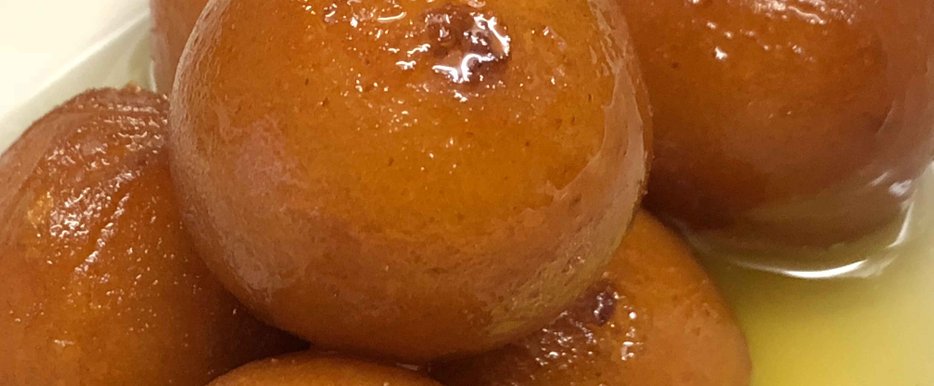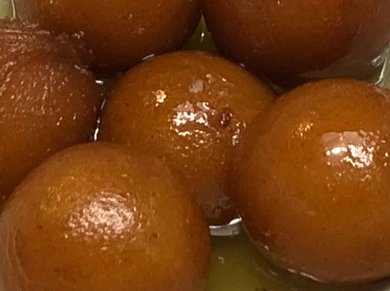Gulab Jamun
Gulab jamun (also spelled gulaab jamun) is a berry-sized ball dipped/soaked in rose flavoured sugar syrup. It is a milk-solid-based South Asian sweet, originating in the Indian subcontinent, notably popular in India, Nepal (where it is known as lal mohan), Pakistan, and Bangladesh (where it is known as gulab jam), as well as Myanmar.
It is also common in Mauritius, Fiji, southern and eastern Africa, Malay Peninsula, and the Caribbean countries of Trinidad and Tobago, Guyana, Suriname and Jamaica.
Gulab jamun is made mainly from milk solids, traditionally from Khoa, which is milk reduced to the consistency of a soft dough. Modern recipes call for dried/powdered milk instead of Khoa. It is often garnished with dried nuts such as almonds or pistachios to enhance flavour.
The word "gulab" is derived from the Persian words gol (flower) and āb (water), referring to the rose water-scented syrup. "Jamun" or "jaman" is the Hindi-Urdu word for Syzygium jambolanum, an Indian fruit with a similar size and shape.
Gulab jamun is a dessert often eaten at festivals, birthdays or major celebrations such as marriages, the Muslim celebrations of Eid ul-Fitr and Eid al-Adha, and the Hindu festival of Diwali (the Indian festival of light). There are various types of gulab jamun and every variety has a distinct taste and appearance.
Gulab jamun is a very popular and delicious dessert and is quite popular in all age groups.
I learned making gulab jamuns from my mother. She used to make gulab jamuns on Diwali festival (a very popular and an important festival of India). Also on Rakhi also known as Raksha Bandhan, also another important festival of India.
You may make gulab jamuns with khoa or milk powder. Here I am sharing the recipe where I am using milk powder. Use full cream milk powder to make the gulab jamuns.
 Recipe Servings: 14
Recipe Servings: 14
 Cooking time: 30 Minutes
Cooking time: 30 Minutes
Ingredients
For Gulab Jamun
- Milk powder (full cream) - 1 cup
- All Purpose Flour (Maida) - 6 tbsp
- Ghee or Oil - 1 tsp
- Milk - 2 tbsp or as needed
- Yogurt (Curd/Dahi) - 1 tbsp
- Baking Soda - a pinch
- Ghee or Oil - for deep frying
- Ghee or Oil - for greasing
- Pistachios (chopped)- for garnishing (optional)
For Sugar Syrup
- Sugar - 1.5 cups
- Green Cardamom pods - 3-4
- Water - 1.5 cups
- Rose water - 1 tsp
- Lemon juice - 1 tsp
Preparation
For Sugar Syrup
- Take a deep pot or a pan. Add sugar, water and crushed cardamoms into it. Bring it to a boil.
- Boil the sugar syrup until it turns slightly sticky. Turn off the stove as it turns to a 1 string consistency.
- Add lemon juice to stop crystallisation process and also add rose water and mix. Keep it aside for later use.
For Gulab Jamuns
- Take a large mixing bowl, add milk powder, all purpose flour (maida) and baking soda into it and mix properly.
- Add ghee to it. Mix it again.
- Take a small bowl, mix yogurt and 2 tbsp milk in it properly. Then add 1.5 tbsp of this mixture to the flour mixture.
- Now start kneading the flour to make a dough. The dough must not be soggy. It must be knead in such a way that it should hold the shape well.
- If the dough is too dry, you can add milk and curd mixture into it. Do not add a lot. Use only as is required.
- Grease your fingers with ghee properly and start making gulab jamun balls.
- Divide the dough into 14 equal sized portions. Roll these dough portions into balls.
- Roll them to smooth balls without any cracks. Keep them covered. If there will be cracks then there are chances that the gulab jamun may break while frying.
- Heat ghee or oil in a pan on a medium heat to deep fry the gulab jamun balls.
- When the ghee is moderately hot, add gulab jamun balls into it one by one.
- You can check if the temperature is right for the gulab jamuns, by dropping a small piece of dough into the oil. If it rises slowly without changing its colour, the temperature is perfect. But if it rises rapidly then you need to cool the oil a bit before adding gujab jaumns into oil.
- If the oil is very hot then the gulab jamuns will turn brown from outside but will not get properly cooked from inside.
- Also check if the sugar syrup is hot. If it is not hot, heat it up a bit. The syrup must be hot and not very hot.
- Fry the gulab jamun balls on a medium flame until it turns golden evenly. To fry them evenly, keep stirring them gently occasionally.
- Add the golden fried gulab jamuns to the hot sugar syrup. Let them rest for atleast 3 hours and then serve.
- You may also garnish gulab jamuns with chopped pistachios before serving.
- Enjoy yummy gulab jamuns.



